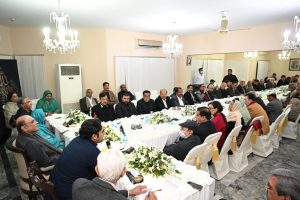With the February 8 elections to Pakistan’s National Assembly and provincial assemblies failing to yield a clear winner capable of forming a stable federal government, the country is roiled in uncertainty.
According to final results announced by the Election Commission of Pakistan, independent candidates secured the most seats by winning 101 of the 264 seats contested in the recent election. Of these, an impressive 93 were backed by Imran Khan’s Pakistan Tehreek-e-Insaf (PTI). Facing legal obstacles that prevented the party from participating directly in the elections, its leaders contested as independents. The Pakistan Muslim League-Nawaz (PML-N) emerged as the party with the most seats (75), followed by the Pakistan People’s Party (PPP) (54).
As it stands, no single political party possesses enough seats to form a government at the federal level, as a minimum of 134 seats is required. This situation has forced parties to seek alliances and form coalitions to achieve the necessary numbers for governance.
In a clever attempt to counter the PTI’s narrative that it is being denied the opportunity to form a government, PML-N President and former Prime Minister Shehbaz Sharif has extended an invitation to the PTI to form the government if their victorious candidates can demonstrate sufficient numbers in the parliament. This move by the PML-N is a smart one, considering that the PTI lacks the required numbers and has categorically dismissed any prospects of negotiations with the PML-N and PPP at the national level.
Adding another twist to the political landscape, both the PML-N and PPP have agreed in principle to collaborate and form a government together. With the numerical strength to achieve this objective, the question now arises: who will be the preferred candidate for the position of prime minister?
Both the PPP and PML-N harbor ambitions of having their respective candidates take on this crucial role. The ensuing power struggle is bound to shape the course of the political arena in the coming days. As the situation develops, it remains to be seen how these parties handle this delicate matter and whether a consensus can be reached.
Seemingly, the chances of three-time Prime Minister and PML-N supremo Nawaz Sharif becoming the country’s premier are diminishing. There are indications that Pakistan’s powerful security establishment favors his brother, Shehbaz, for the top position. Shehbaz has previously demonstrated his ability to run a coalition government effectively.
The question is whether the PPP will find this arrangement acceptable.
The PPP is keen on extracting the most it can before entering a coalition with the PML-N. It has nominated Chairman Bilawal Bhutto Zardari for the top post.
However, the possibility of the PPP initiating discussions with Imran Khan’s party cannot be ruled out. Much will depend on the unfolding dynamics between Khan, who is currently in prison after four separate convictions, and the military establishment.
Given the dominant role that the military continues to play in Pakistan politics and the acrimonious relationship between the generals and the PTI, political parties may not be keen to form a coalition with PTI-backed candidates to secure the prime minister’s position.
The only two major parties with enough seats in the national legislature that have demonstrated a willingness to work together are the PML-N and PPP. It is evident that they will need to collaborate and negotiate an arrangement in the coming days.
Interestingly, the fact that these two parties have come together so quickly after the elections suggests that they may have been nudged by the military to do so. By creating the perception that they will form the next government, the Pakistani establishment is perhaps seeking to dispel public perceptions of political instability in the country.
It is plausible that the military wants the PML-N and PPP to move swiftly toward a power-sharing agreement, not only to counter the growing PTI pressure but also to ensure the continuation of the economic program that was initiated under the previous Shehbaz-led PML-N/PPP coalition government, as well as the caretaker government under interim Prime Minister Anwaar-ul-Haq Kakar that followed.
Currently, the key state institutions do not appear to be inclined to work with Khan.
Following the elections, Army Chief Asim Munir issued a statement saying, “Elections are not a zero-sum competition of winning and losing but an exercise to determine the mandate of the people.” Denouncing the “politics of anarchy and polarization,” he stressed that the “nation needs stable hands and a healing touch to move on.” Although not explicitly stated, some have interpreted these comments as referring to Khan, who has opted for agitation over talking to his political opponents.
The fact is that the PTI holds a significant number of seats in the new National Assembly and could choose to sit in the opposition, thereby making life difficult for the new premier. With an active PTI opposition, any government would face constant pressure and struggle to function with confidence.
The PML-N and PPP need to consider these dynamics and work towards a collaborative and stable governance model to navigate through the challenges that lie ahead.
There will be more drama in the coming days as all political parties navigate their interests with the nation and international community watching intently.

































